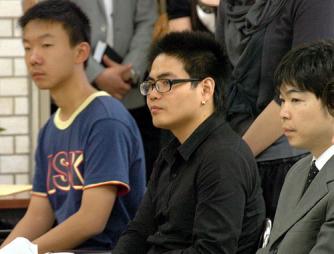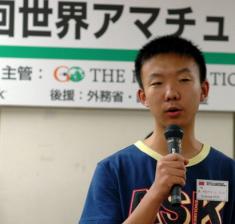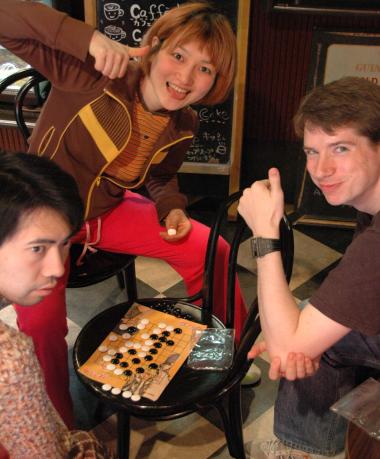The American Go E-Journal is covering the 29th annual World Amateur Go Championship this week in Tokyo, Japan. Top amateurs from 68 countries are competing in the 8-round tournament. Watch the AGA website for real-time updates – including event reports, photos and game records – as well as special WAGC editions of the EJ this week. Unless o
 therwise
noted, all reporting is by EJ Managing Editor Chris Garlock and
photographs are by John Pinkerton.
therwise
noted, all reporting is by EJ Managing Editor Chris Garlock and
photographs are by John Pinkerton.FEW SUPRISES AFTER 1ST 2 WAGC ROUNDS: While most of the top seeds at the World Amateur Go Championships are winning, as expected, in the early rounds, there were several notable upsets in Tuesday’s first two rounds. Fifth-ranked Tsung-Lin Yang of Chinese Taipei fell to 29th-seeded Ruechagorn Trairatananusorn of Thailand in Round 2 and Antonio Fernandez Caballero of Cuba (r), seeded 32nd, narrowly defeated 7th-seeded Frank Janssen of The Netherlands by 5.5 points in Round 2. In a third major upset, 26th-ranked Martin
U.S. REP IN GOOD FORM: Despite a grueling 30-hour flight from the U.S. to Tokyo, U.S. rep Mozheng Guan 8d (2nd from l) turned in a convincing performance in Day 1 of the WAGC, forcing resignations by Singapore’s Chee Hiong Chuah 3d (seeded 36th) and Hiroaki Okawa 3d of Brazil (seeded 38th). Both games – with commentary by Kubo Katsuaki 9P (r) – are attached. Katsuaki praised Guan’s “courageous” moves, especially in Round 2, which ended after just 132 moves.

TOP PLAYERS ON STYLE AND ADVICE: Each year, the top three WAGC players and a fourth contestant hold a brief news conference after the first-round pairings. Again this year I was picked to ask the lead-off question and asked all four to describe their styles and to offer advice to other amateurs on how to improve. Here’s what they said: “My game is power-based and relies on thickness,” said Yoshiyuki Tsuchimune, the Japanese WAGC representative. “But the current popular style is fighting, so that’s what I expect we’ll see this week.” Chinese rep Yuzheng Guo said that while his “fighting skill is strong, my endgame is weak. But I never give up.” As an insei, Korean player Sung Bong Ha “specialized in fast fighting, but now I try to get the most of every stone I play.” Portugal’s Christopher Neto had this advice for amateur players: “Be open to ideas and play with stronger players” And, suggested Sung Bong Ha, “Try variations and avoid getting stuck on ideas” Added Yuzheng Guo, “Play your own game, and think about the games you lose and try to improve.” Said Japan’s Yoshiyuki Tsuchimune, “Play a lot of games and get stronger players to review them. Most important is to like to play go.” And interesting side note is that until last year, a Korean amateur who won the WAGC automatically won promotion to professional. Now they get an 8d certificate from the Nihon Kiin and a chance to play in the Korean pro qualifying tournament.
WAGC PLAYER PROFILES: U.S. & China
Mozhen Guan, this year’s U.S. representative to the World Amateur Go Championship (WAGC) was just 14 when he first got interested in go. His father played a bit, and Guan took a go class in Chinese language school in his Holmdel, New Jersey, his hometown. “I really like the competitive aspects of th
 e
game,” Guan told the E-Journal Tuesday at the Nihon Kiin in
Tokyo, after the Round 1 pairings had been drawn. He spent hours
playing on IGS and improved rapidly, moving from 20-kyu to 4-dan in a
matter of months. At fifteen, he went to China to study go for a year
before returning to the United States. He just completed his sophomore
year at UC Berkeley, where he studies math. Don’t look for
long games with deep endgame calculations from Guan’s WAGC
appearance. “I love to fight,” he told the EJ.
“My style comes from studying professional Korean games and
my games usually end in death for either my opponent or me.”
e
game,” Guan told the E-Journal Tuesday at the Nihon Kiin in
Tokyo, after the Round 1 pairings had been drawn. He spent hours
playing on IGS and improved rapidly, moving from 20-kyu to 4-dan in a
matter of months. At fifteen, he went to China to study go for a year
before returning to the United States. He just completed his sophomore
year at UC Berkeley, where he studies math. Don’t look for
long games with deep endgame calculations from Guan’s WAGC
appearance. “I love to fight,” he told the EJ.
“My style comes from studying professional Korean games and
my games usually end in death for either my opponent or me.” Yuzhen Guo (l), the 15-year-old Chinese WAGC rep, has been playing go since he was 6 years old. His father plays and encouraged him to take up the game, he told the EJ Tuesday at the Nihon Kiin. He’s been studying in a school for professionals for the last two years and has taken the pro test four times but has not yet passed. An age limit of 16 or 18 for becoming a pro may be implemented next year, but competition is fierce; only the top 18 players in the qualifying tournament make pro. “I’m good at attacking,” Guo told the EJ, adding that “I like go because it’s fun.” He studies go six hours a day and has been through the school’s life and death books “three or four times each.” He also enjoys playing basketball, soccer and ping pong. Thanks to Mozheng Guan and Yongfei Ge for translation assistance.
MACFADYEN ON MACFADYEN: Matthew Macfadyen 6d (r), the United Kingdom rep and a longtime player well-known in the world go community, took time during the lunch break between rounds on Wednesday to record and comment his Round 1 game (attached) with Chi Thanh Tran of Vietnam for the E-Journal.
HAND TALK: GO FOR THE VISUALLY-IMPAIRED: Having a good “feel” for a position takes on a whole new meaning when the players are visually-impaired. WAGC organizers staged a spellbinding demonstration game Tuesday afternoon with a new “Universal Go Board” jointly developed by the Osaka University of Commerce and Kobe Design University. At the outset of the game, the two players – French W
 AGC rep
Pierre Audouard and Mr. Nakamaru, the top handicapped player in Japan
-- felt the board, which has a grid of raised lines into which the
stones fit, their backs crosshatched with shallow slots that lightly
snap into position. The black stones have a tiny raised bump to
differentiate them from the white stones. There have been many attempts
to develop a workable board for the visually impaired; some of the best
were exhibited at the demonstration game. Once the players familiarized
themselves with the board, they began playing and the cooperative
nature of the game manifested itself beautifully as two sets of hands
met on the board each move. After placing a stone, the French player
tapped the stone, making sure it was set in place, and also sending an
audible signal to the Japanese player not only that he had moved, but
in which area of the board. The Japanese player’s fingers
confirmed the location of the just-placed stone and then lightly flew
across the board checking the position of the stones. The two players
then relaxed into a familiar posture of thought, except that they had
squeezed their eyes completely shut in concentration. Then the Japanese
player’s hands began to roam the board, his fingers lightly
tracing the position of the stones and the spaces between them, mapping
out developing moyos. As the game played out in familiar patterns of
joseki, fuseki and life and death, go and the players together
transcended their “handicap.” Click here for more
photos. For more information on the Society for Popularizing
Go for the Handicapped, email Naoko Kumasaka at igoigoigo2008@gmail.com
AGC rep
Pierre Audouard and Mr. Nakamaru, the top handicapped player in Japan
-- felt the board, which has a grid of raised lines into which the
stones fit, their backs crosshatched with shallow slots that lightly
snap into position. The black stones have a tiny raised bump to
differentiate them from the white stones. There have been many attempts
to develop a workable board for the visually impaired; some of the best
were exhibited at the demonstration game. Once the players familiarized
themselves with the board, they began playing and the cooperative
nature of the game manifested itself beautifully as two sets of hands
met on the board each move. After placing a stone, the French player
tapped the stone, making sure it was set in place, and also sending an
audible signal to the Japanese player not only that he had moved, but
in which area of the board. The Japanese player’s fingers
confirmed the location of the just-placed stone and then lightly flew
across the board checking the position of the stones. The two players
then relaxed into a familiar posture of thought, except that they had
squeezed their eyes completely shut in concentration. Then the Japanese
player’s hands began to roam the board, his fingers lightly
tracing the position of the stones and the spaces between them, mapping
out developing moyos. As the game played out in familiar patterns of
joseki, fuseki and life and death, go and the players together
transcended their “handicap.” Click here for more
photos. For more information on the Society for Popularizing
Go for the Handicapped, email Naoko Kumasaka at igoigoigo2008@gmail.com

THE TRAVELING BOARD: Sunday Afternoon At Ben’s Café
by Chris Garlock
Ben’s Café brings a distinctly European style to the Tokyo go club scene. Tucked away in the Takadanobaba district, Ben’s is a longtime magnet for many expat and visiting go players – as well as local go players -- who gather on Sundays to while away the afternoon over a game and a cup of coffee or a beer. EJ photog John Pinkerton and I met up there last Sunday with Jeremy Banzhaf, our go-to Man in Tokyo, for a game over lunch. An excellent café that also offers go – rather than a club that also has food -- Ben’s menu of Western food includes a BLT with avocado so good – juicy tomatoes, tasty bacon, crisp lettuce and perfectly ripe avocado – that I suspect Jeremy was trying to distract me from the game. It very nearly worked. For those craving a cup of black tea in the land where green tea rules in all its glory, Ben’s delivers a proper pot of Earl Grey or Darjeeling. Stored along with the go boards are other games, including scrabble, backgammon, chess, and playing cards. Several other regulars dropped by while we were there, including Dave Adams, a Brit who joined us in the post-game analysis, which featured several complex life and death problems. In addition to the go boards Ben’s also offers free wireless access, poetry readings, aromatherapy, magic shows and live music. You never know who you’ll bump into at Ben’s: a large group of Japanese ladies stopped by after church for lunch as we played, and on our way out later, we visited briefly with Modern Girl & Sniper, a young Japanese electronica duo who were learning to play from Adam Harding, another Brit.
photos by John Pinkerton. Click here for more photos.
Published by the American Go Association
Managing Editor: Chris Garlock
Assistant Editor: Bill Cobb
Professionals: Yilun Yang 7P; Alexandr Dinerchtein 3P; Fan Hui 2P
Contributors: Paul Barchilon (Youth Editor); Lawrence Ku (U.S. West Coast Reporter); Brian Allen (U.S. West Coast Photo Editor); Peter Dijkema (Dutch/European Correspondent); Marilena Bara (Romania/European Correspondent); Ian Davis (Ireland Correspondent)
Columnists: James Kerwin 1P; Kazunari Furuyama; Rob van Zeijst; Roy Laird; Peter Shotwell
Translations: Chris Donner (Japan); Bob McGuigan (Japan); Matt Luce (China)
Text material published in the AMERICAN GO E JOURNAL may be reproduced by any recipient: please credit the AGEJ as the source. PLEASE NOTE that commented game record files MAY NOT BE published, re-distributed, or made available on the web without the explicit written permission of the Editor of the E-Journal. Please direct inquiries to journal@usgo.org
Articles appearing in the E-Journal represent the opinions of the authors and do not necessarily reflect the official views of the American Go Association.